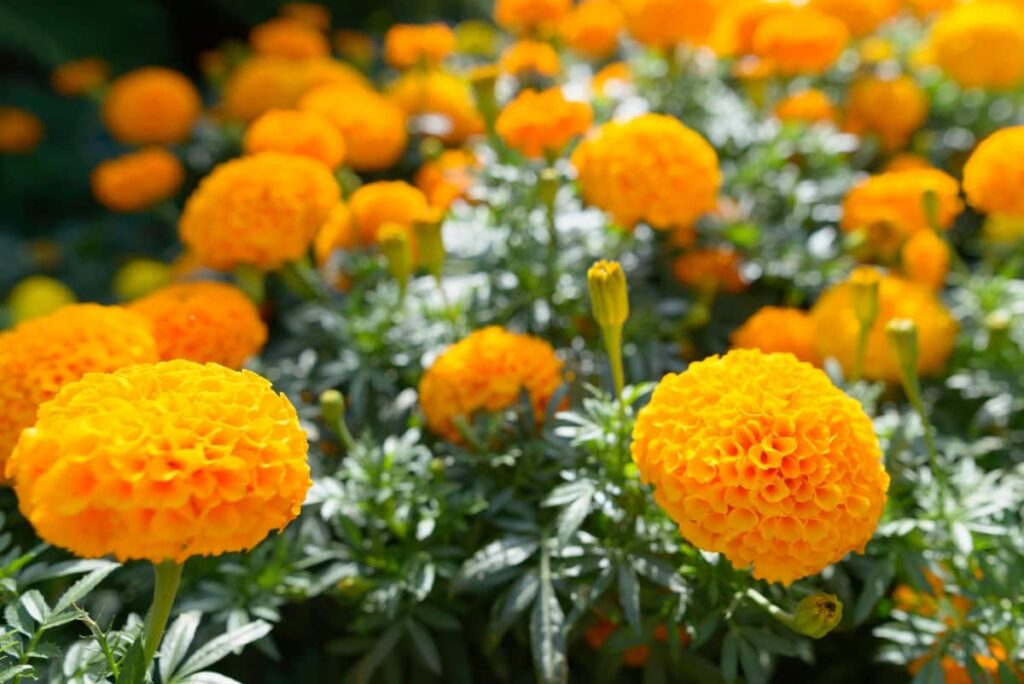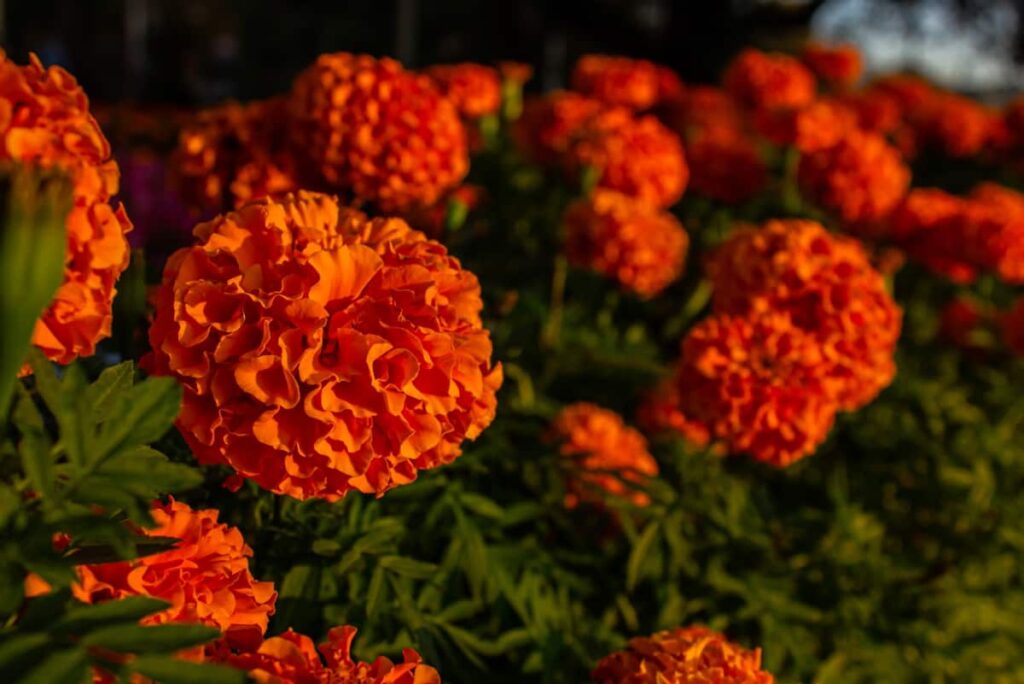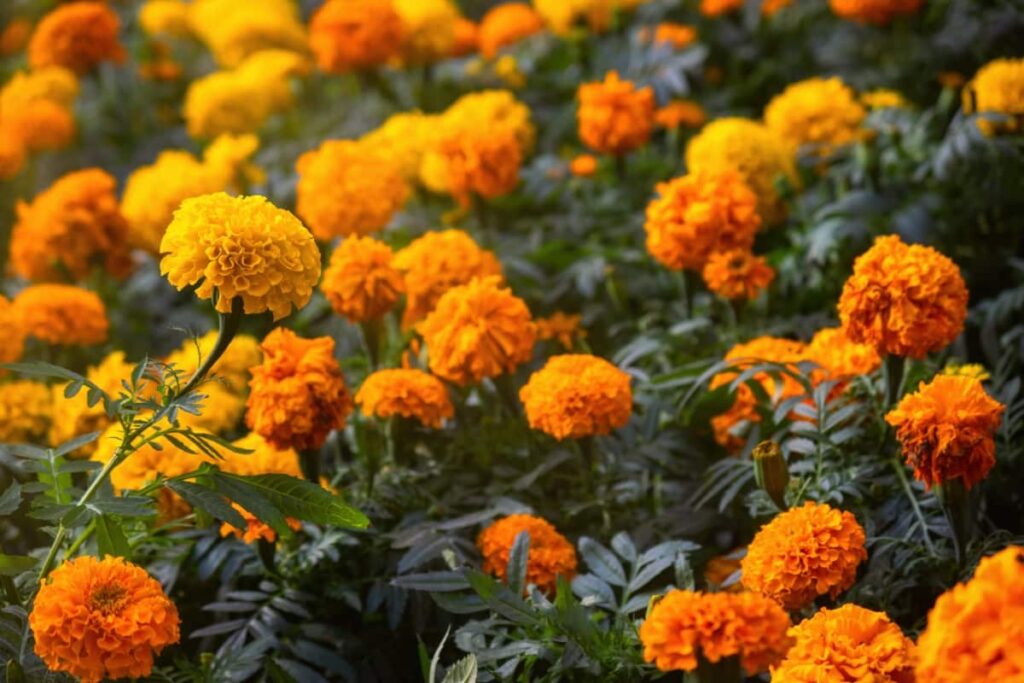Marigold (genus Tagetes) is a genus of about 50 species of annual herbs of the family belonging to aster (Asteraceae). Flowering issues in Marigold plants can be caused by various factors that are essential to address for optimal growth and vibrant blooms. Understanding these reasons can help you troubleshoot and provide effective solutions to encourage flowering.

10 Reasons Why Your Marigold is Not Blooming
Insufficient Sunlight
One possible reason for Marigold won’t bloom could be insufficient sunlight. Marigolds thrive in full sun, requiring at least 6-8 hours of direct sunlight daily to bloom beautifully. When planted in shady areas or where taller plants shade them, Marigolds may struggle to produce vibrant blooms. Without adequate sunlight, the plants may focus more on survival than flowering.
Enhancing Marigold flowering can be a rewarding experience for any gardener looking to brighten up their outdoor space. If you notice your Marigold not blooming as expected, try relocating it to a sunnier spot. Ensure it receives the necessary sunlight for optimal growth and blooming potential. Remember, light is essential for photosynthesis and flower production in Marigolds.
Inadequate Watering
Marigold plants are relatively low-maintenance, but they do require consistent moisture to thrive. When it comes to watering your Marigolds, the key is finding the right balance. Overwatering the Marigold plant can lead to root rot, while underwatering can affect the lack of blooms. To ensure your Marigolds are getting enough water, check the soil regularly. Stick your finger into the soil up to an inch deep – if it feels dry, it’s time to water. Water deeply at the base of the plant early in the morning or late in the evening to prevent evaporation.
Poor Soil Quality
Poor soil quality can be a major factor contributing to your Marigold not blooming as expected. When the soil lacks essential nutrients or has poor drainage, it can hinder the plant’s ability to thrive and produce beautiful flowers. Marigolds require well-draining soil rich in organic matter to support healthy growth.
To address poor soil quality, consider amending the soil with organic matter. This will help provide the necessary nutrients for robust growth and vibrant flowering throughout the season. Regularly testing the soil pH levels can also guide you in making adjustments to create an optimal environment for Marigolds.
Over-Fertilization
Over-fertilization can be a common mistake that gardeners make when trying to encourage their Marigold plants to bloom. While we all want our flowers to thrive, sometimes less is more when it comes to feeding them nutrients. Excessive fertilization can hinder the blooming process by causing an imbalance in the soil composition. When Marigolds receive too much fertilizer, they may focus on producing lush green foliage instead of focusing their energy on flowering.
In case you missed it: How to Grow Marigold at Home in the USA: From Seeds and Cuttings in the Backyard, and Pots

This can result in stunted or delayed blooming, leaving you disappointed with the lack of vibrant blooms in your garden. To avoid over-fertilizing your Marigolds, it’s important to follow the recommended guidelines for feeding and use a balanced fertilizer specifically formulated for flowering plants. Always remember that moderation is important to providing nutrients for your beloved Marigold plant.
Pests and Diseases
Pests and diseases can affect your Marigold plants, causing them to struggle with blooming. Common pests like aphids, spider mites, and caterpillars can munch on leaves and buds, hindering flower production. To combat these pesky invaders, consider using natural remedies like neem oil or introducing beneficial insects like ladybugs to your garden.
Moreover, fungal diseases such as powdery mildew and botrytis can also affect the flowering ability of your Marigolds. Ensure good air circulation around the plants by avoiding overcrowding and watering at the base to prevent fungal growth. Using disease-resistant varieties of Marigolds can also help in preventing infections. Regularly inspecting your Marigold plants for any signs of pest infestation or disease is crucial in maintaining their health and promoting blooming.
Incorrect Plant Spacing
Incorrect plant spacing can be a common issue when it comes to growing Marigolds. When plants are too close together, they end up competing for sunlight, water, and nutrients. This competition can be affected by stunted plant growth and fewer blooms. Spacing Marigold plants correctly is crucial for optimal growth and blooming. Proper spacing is crucial for ensuring that each Marigold plant has enough room to thrive. Typically, Marigolds should be spaced about 8-10 inches apart in the garden.
By giving them adequate space, you allow for proper air circulation, which helps prevent diseases from spreading among the plants. When Marigolds are overcrowded, they also tend to become leggy as they stretch out in search of light. This affects their appearance and can also impact their ability to flower abundantly. To avoid issues with incorrect plant spacing, take the time to plan out your garden layout before planting.
Improper Pruning Practices
When you trim too much or at the wrong time, you risk affecting the plant’s ability to produce flowers. Remember, Marigolds thrive when they have enough foliage to support flower growth. Avoid cutting back more than a third of the plant at once. Over-pruning can stress the Marigold and delay or reduce its flowering capabilities. It’s essential to prune strategically by removing spent blooms regularly without excessive trimming.
When deadheading, make sure to snip above a leaf node rather than randomly cutting stems. This technique encourages new growth and promotes continuous blooming throughout the season. By practicing proper pruning methods, you can help your Marigold reach its full flowering potential.
Lack of Deadheading
Lack of deadheading can hinder your Marigold plants from blooming to their full potential. Deadheading is the process of removing faded or wilting flowers from the plant. By doing so, you redirect the plant’s energy into producing new blooms rather than setting seeds. This simple practice encourages continuous flowering throughout the season. Deadheading Marigolds for blooms is a simple yet effective practice to encourage continuous flowering in your garden.
In case you missed it: Growing Marigold – A Beginners Guide

If you neglect deadheading, your Marigolds may start focusing on seed production rather than blooming profusely. As a result, you might notice fewer flowers and a shorter Marigold blooming period. To keep your Marigolds looking vibrant and colorful all season long, make sure to deadhead them regularly. It’s a quick and easy task that pays off in beautiful blooms.
Extreme Weather Conditions
Extreme weather conditions can have a main impact on your Marigold plants, causing them to struggle with blooming. High temperature levels can cause stress to the plants, leading to reduced flower production. On the other hand, sudden drops in temperature or frost can damage the delicate blooms of Marigolds, hindering their ability to bloom properly.
Excessive rain or humidity can also create ideal conditions for fungal diseases that affect flowering. To protect your Marigolds from extreme weather, consider providing some shade during scorching hot days or covering them during unexpected cold snaps. Mulching around the plant base can help regulate soil temperature and moisture levels.
Plant Age and Maturity
As your Marigold plant grows, its age and maturity play a crucial role in blooming. Young Marigolds may take some time to establish themselves before producing vibrant flowers. Patience is to wait for your Marigold to reach its full potential. Remember that each plant has its timeline for growth and flowering.
Mature Marigolds have stronger root systems and are better equipped to bloom abundantly. Providing proper care and maintenance throughout the plant’s life cycle can help promote healthy growth and flowering. Adjusting your care routine according to the plant’s age can make a significant difference in its blooming success.
In case you missed it: 10 Reasons Why Your Potted Plant is Not Blooming: Remedies and Treatment

Conclusion
Marigolds are known for their cheerful blooms and easy-going nature, but sometimes, they need a little extra care to reach their full flowering potential. There could be various reasons for fixing Marigold flowering issues. Inadequate watering, overwatering, and poor soil quality can impact blooming. By addressing common issues for Marigolds not blooming effectively, you can enhance the flowering capacity of your Marigold plants beautifully blooming all season long.
- Crops Grown in Summer Season: Best Choices for Summer Gardening
- Organic Pest Control for Tomato Farming
- How to Maximize Sheep Farming Profit
- Broccoli Varieties: Choosing the Right Cultivars for Your Farm
- How to Raise Pigs in Your Own Backyard: A Comprehensive Guide
- Budget Friendly Sheep Shed Ideas: Cheap and Low-Cost Tips
- How Much Do Cattle Farmers Make: Revenue Streams in Cattle Farming
- Management Pests and Diseases in Your Cotton Field
- Sheep Farming Business Plan for Beginners
